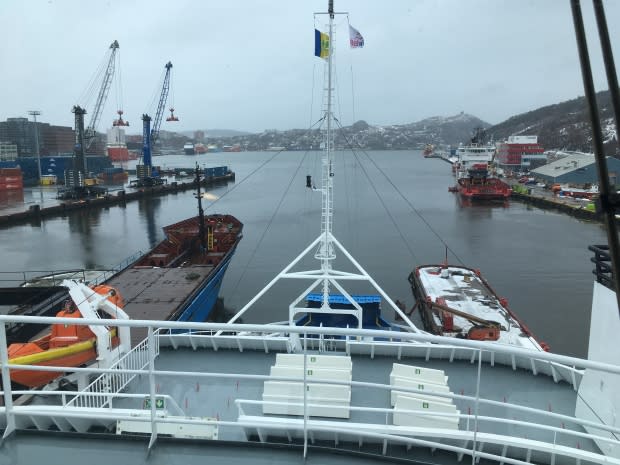Labrador's shiny new ferry unveiled, but don't forget your European adapters
A refurbished Norwegian vessel that will take the place of a retired Labrador ferry was unveiled Tuesday, much to the joy of politicians who offered a tour of the ship ahead of its launch this month.
The Qajaq W — Inuktitut for "kayak," and pronounced the same way — will take its maiden Strait of Belle Isle voyage as soon as this week, according to Transportation Minister Steve Crocker.
"It's really going to be an enjoyable crossing," said Crocker. "The people of the strait have been long deserving of this vessel, and I'm confident they're going to like what they see."
The benefits of the seven-year-old Qajaq are many, according to its proponents, who touted the ship during a media tour Tuesday. It may use only half as much fuel as the 49-year-old Apollo ferry, retired in December, Crocker said.
Its handling in icy waters is also expected to exceed the Apollo, which sometimes faced delays caused by its need to turn around in a small, ice-ridden harbour.

The Qajak, however, will never need to turn around.
"This vessel, because it's a double-ender, will always go directly in," said Peter Woodward, president of Labrador's Woodward Group, which bought the ferry and will operate the run via its subsidiary, Labrador Marine.
The ferry will face some of the worst sea conditions in Canada, he added, but Woodward remains confident in the ship's capabilities. "It was designed by Norwegians, for ice," he said.
The provincial government signed a multiyear, $362-million ferry deal with Woodward Group last fall. The contract for the Strait of Belle Isle is valued at approximately $11.9 million per year for a 12-year term.
The company has not disclosed what it paid for the vessel.
New look for new-ish ferry
In the months following the purchase, crews refitted the vessel from stem to stern: carpets and seats have been ripped up, flooring redone, and the ship completely repainted.

But a few holdovers from its days on European waters remain, such as the cafeteria menu, with its prices still denoted in euros.
Similarly, electrical outlets haven't been changed to the North American standard, which could leave passengers without a way to charge their devices.

The Qajaq has a capacity of 350 people, plus 120 cars and eight commercial spaces. The Apollo's capacity, when it was used in Newfoundland and Labrador, was 240 passengers and up to 60 cars. However, when the Apollo was used in the Baltic Sea, it would have carried far more than that — up to 1,500 passengers, according to Labrador Marine.
The new ferry will help tourists that may take advantage of revamped infrastructure in Labrador, Crocker said.
"We're opening up a new part of this province that a lot of people in the past may not have travelled," he said. "I think the tourism potential in Labrador is immense. This vessel is going to add to that experience."
The Qajaq is one of two new ferries acquired to service Labrador this year. Its sister ship, expected to set sail in May along Labrador's north coast, was also outfitted with 80 beds. Both vessels are owned and operated by Woodward Group.
Environment Minister Graham Letto said the Apollo has since been sold to Quebec.
Read more from CBC Newfoundland and Labrador

